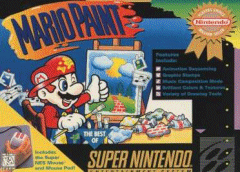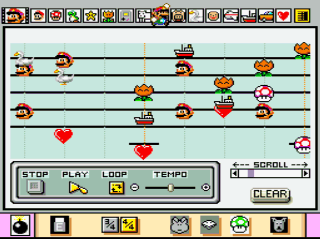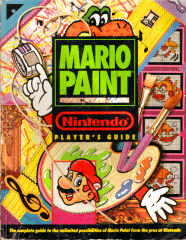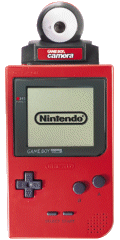Mario Paint And The Case For The "Creativity Carts"
Admittedly, most of us would buy a game system for one specific purpose only
-- to play videogames. Very few would do this kind of purchase if what we intend to do with the game system is anything
else but play videogames. If we wanted to watch DVD movies, a stand-alone DVD player would be considered more than a Playstation
2 or an X-Box as a viable purchase -- which is not saying that these systems can't do a good job playing DVDs. Similarly, if a
person wanted to learn how to create computer graphics or do animation, a better choice would be a PC or Macintosh with a printer,
a scanner, and all the necessary storage drives and ports for plug-in devices such as digital cameras. "Creativity carts", a
suitable title for the fledgling category of games for console units that deal in artistic rather than gaming applications, tend
to be looked down by the majority of gamers who think they basically have no place for existence except on a personal computer,
since without the necessary components like printers and disk drives, these would have very little use except as toys or as
equipment for budget-minded video producers.
 So why am I defending the likes of Nintendo's Mario Paint for the Super NES?
Well, simply that there hasn't been such a program for a videogame system that was so well designed for the purpose of introducing
game players who have never owned a computer to the wonders of using a computer-like application, while at the same time introducing
those who are too shy to even consider using a videogame system to its rather tame learning environment. Let's face it -- a videogame
system is at heart a computer made specifically for gaming, yet a computer nonetheless, and in this day and age it's getting a little
hard to get by without learning how to use one. Even children at a very early age are getting to know how to use a computer at home,
using the same one their parents use for writing letters, doing up family budgets, and storing vital information. And if a child can't
get on the computer because their parents are using it, there are self-contained alternatives like the V-Tech Video Painter and the
Sega Pico system which bring such ease and versatility to the children's learning.
So why am I defending the likes of Nintendo's Mario Paint for the Super NES?
Well, simply that there hasn't been such a program for a videogame system that was so well designed for the purpose of introducing
game players who have never owned a computer to the wonders of using a computer-like application, while at the same time introducing
those who are too shy to even consider using a videogame system to its rather tame learning environment. Let's face it -- a videogame
system is at heart a computer made specifically for gaming, yet a computer nonetheless, and in this day and age it's getting a little
hard to get by without learning how to use one. Even children at a very early age are getting to know how to use a computer at home,
using the same one their parents use for writing letters, doing up family budgets, and storing vital information. And if a child can't
get on the computer because their parents are using it, there are self-contained alternatives like the V-Tech Video Painter and the
Sega Pico system which bring such ease and versatility to the children's learning.
 One of the things Nintendo did to make Mario Paint appealing as a learning tool
was to market it as the first Super NES cartridge to use its compatible mouse controller -- a small white mouse with purple buttons
that resembled the mouse controllers of personal computers. Although somewhat clunky to use, the Super NES mouse inspired Sega and
even Sony to develop and release mouse controllers for their systems, even for games that a control pad would be unsuitable for.
Another company released the Champ Mouse, a more comfortable alternative to the Super NES mouse controller.
One of the things Nintendo did to make Mario Paint appealing as a learning tool
was to market it as the first Super NES cartridge to use its compatible mouse controller -- a small white mouse with purple buttons
that resembled the mouse controllers of personal computers. Although somewhat clunky to use, the Super NES mouse inspired Sega and
even Sony to develop and release mouse controllers for their systems, even for games that a control pad would be unsuitable for.
Another company released the Champ Mouse, a more comfortable alternative to the Super NES mouse controller.
 Another thing Nintendo did was make Mario Paint do more than just mimick the
workings of computer programs like Microsoft Paint for Windows. It also featured a do-it-yourself animation option that allowed
you to create a animated "sprite" character that could feature up to 9 frames of animation, to control the speed of the animation's frame
cycling, and to direct the path of your animation. Its other feature is a music composition option that allowed you to create your own
music using different instruments and sound effects coded to various iconic images, and a game called Gnat Attack where you can test
out your mouse controller on a game where swatting insects with your on-screen fly swatter while avoiding their "bug bombs" is the name
of the game.
Another thing Nintendo did was make Mario Paint do more than just mimick the
workings of computer programs like Microsoft Paint for Windows. It also featured a do-it-yourself animation option that allowed
you to create a animated "sprite" character that could feature up to 9 frames of animation, to control the speed of the animation's frame
cycling, and to direct the path of your animation. Its other feature is a music composition option that allowed you to create your own
music using different instruments and sound effects coded to various iconic images, and a game called Gnat Attack where you can test
out your mouse controller on a game where swatting insects with your on-screen fly swatter while avoiding their "bug bombs" is the name
of the game.
 If that wasn't enough, Nintendo in the year following Mario Paint's release published
a Player's Guide that showed players not only how to use Mario Paint, but also how it can be used for creating various animated scenes
from games like Legend Of Zelda: A Link To The Past, Star Fox, Street Fighter II, Teenage Mutant Ninja Turtles, and
Plok!, plus suggestions for using the program for video introductions, productions, and endings, with sample images of a cartoon video
for Otis Reddings' "Sittin' On The Dock Of The Bay" developed by photographer Steve Miller.
If that wasn't enough, Nintendo in the year following Mario Paint's release published
a Player's Guide that showed players not only how to use Mario Paint, but also how it can be used for creating various animated scenes
from games like Legend Of Zelda: A Link To The Past, Star Fox, Street Fighter II, Teenage Mutant Ninja Turtles, and
Plok!, plus suggestions for using the program for video introductions, productions, and endings, with sample images of a cartoon video
for Otis Reddings' "Sittin' On The Dock Of The Bay" developed by photographer Steve Miller.
 While Mario Paint is neither the first "creativity cart" -- such things have existed on
systems even as far back as the Bally Professional Arcade (a.k.a. the Astrocade) with its built-in Scribbling program -- nor is it the best,
it has been influential in the development of Nintendo's other "creativity cart", the Gameboy Camera for the Gameboy system, the first to
introduce a low-cost form of digital photography where captured snapshots can be manipulated for animations and even printed out on paper through
the optional Gameboy Printer accessory. Mario Paint also influenced the development of the Super Gameboy adapter for the Super NES, a hardware
emulator in cartridge format, by including a customizable border feature where players can create their own borders for whatever Gameboy game they're
playing -- though it lacks a battery save feature to be able to preserve the custom borders for later use.
While Mario Paint is neither the first "creativity cart" -- such things have existed on
systems even as far back as the Bally Professional Arcade (a.k.a. the Astrocade) with its built-in Scribbling program -- nor is it the best,
it has been influential in the development of Nintendo's other "creativity cart", the Gameboy Camera for the Gameboy system, the first to
introduce a low-cost form of digital photography where captured snapshots can be manipulated for animations and even printed out on paper through
the optional Gameboy Printer accessory. Mario Paint also influenced the development of the Super Gameboy adapter for the Super NES, a hardware
emulator in cartridge format, by including a customizable border feature where players can create their own borders for whatever Gameboy game they're
playing -- though it lacks a battery save feature to be able to preserve the custom borders for later use.
 It's too bad there isn't more "creativity carts" like Mario Paint released for the modern-age
game systems like the Gamecube, the Playstation 2, and the X-Box. Nintendo's latest attempt to update Mario Paint for the Nintendo 64 system,
unfortunately, didn't get far beyond the shores of Japan, where it is available as a series of creativity programs called Mario Artist for the
Dynamic Drive adapter. And the only thing that exists in the form of a "creativity cart" for the Playstation and its sequel system is Codemasters'
MTV Music Generator, which lets you play around with various sound samples for creating your own tunes. However, with game systems going further
beyond the boundaries of being a mere gaming system, such as including online Internet access for playing games with other players across town or across
the country, it's only a matter of time before game companies may see the virtue and benefits of producing "creativity carts" for the sake of using whatever
players created from their imaginations as a part of their gaming software, such as creating "skins" for characters of games like the latest installment
of Quake and what-not. The possibilities of such useage are limitless.
It's too bad there isn't more "creativity carts" like Mario Paint released for the modern-age
game systems like the Gamecube, the Playstation 2, and the X-Box. Nintendo's latest attempt to update Mario Paint for the Nintendo 64 system,
unfortunately, didn't get far beyond the shores of Japan, where it is available as a series of creativity programs called Mario Artist for the
Dynamic Drive adapter. And the only thing that exists in the form of a "creativity cart" for the Playstation and its sequel system is Codemasters'
MTV Music Generator, which lets you play around with various sound samples for creating your own tunes. However, with game systems going further
beyond the boundaries of being a mere gaming system, such as including online Internet access for playing games with other players across town or across
the country, it's only a matter of time before game companies may see the virtue and benefits of producing "creativity carts" for the sake of using whatever
players created from their imaginations as a part of their gaming software, such as creating "skins" for characters of games like the latest installment
of Quake and what-not. The possibilities of such useage are limitless.
 So why am I defending the likes of Nintendo's Mario Paint for the Super NES?
Well, simply that there hasn't been such a program for a videogame system that was so well designed for the purpose of introducing
game players who have never owned a computer to the wonders of using a computer-like application, while at the same time introducing
those who are too shy to even consider using a videogame system to its rather tame learning environment. Let's face it -- a videogame
system is at heart a computer made specifically for gaming, yet a computer nonetheless, and in this day and age it's getting a little
hard to get by without learning how to use one. Even children at a very early age are getting to know how to use a computer at home,
using the same one their parents use for writing letters, doing up family budgets, and storing vital information. And if a child can't
get on the computer because their parents are using it, there are self-contained alternatives like the V-Tech Video Painter and the
Sega Pico system which bring such ease and versatility to the children's learning.
So why am I defending the likes of Nintendo's Mario Paint for the Super NES?
Well, simply that there hasn't been such a program for a videogame system that was so well designed for the purpose of introducing
game players who have never owned a computer to the wonders of using a computer-like application, while at the same time introducing
those who are too shy to even consider using a videogame system to its rather tame learning environment. Let's face it -- a videogame
system is at heart a computer made specifically for gaming, yet a computer nonetheless, and in this day and age it's getting a little
hard to get by without learning how to use one. Even children at a very early age are getting to know how to use a computer at home,
using the same one their parents use for writing letters, doing up family budgets, and storing vital information. And if a child can't
get on the computer because their parents are using it, there are self-contained alternatives like the V-Tech Video Painter and the
Sega Pico system which bring such ease and versatility to the children's learning. One of the things Nintendo did to make Mario Paint appealing as a learning tool
was to market it as the first Super NES cartridge to use its compatible mouse controller -- a small white mouse with purple buttons
that resembled the mouse controllers of personal computers. Although somewhat clunky to use, the Super NES mouse inspired Sega and
even Sony to develop and release mouse controllers for their systems, even for games that a control pad would be unsuitable for.
Another company released the Champ Mouse, a more comfortable alternative to the Super NES mouse controller.
One of the things Nintendo did to make Mario Paint appealing as a learning tool
was to market it as the first Super NES cartridge to use its compatible mouse controller -- a small white mouse with purple buttons
that resembled the mouse controllers of personal computers. Although somewhat clunky to use, the Super NES mouse inspired Sega and
even Sony to develop and release mouse controllers for their systems, even for games that a control pad would be unsuitable for.
Another company released the Champ Mouse, a more comfortable alternative to the Super NES mouse controller. Another thing Nintendo did was make Mario Paint do more than just mimick the
workings of computer programs like Microsoft Paint for Windows. It also featured a do-it-yourself animation option that allowed
you to create a animated "sprite" character that could feature up to 9 frames of animation, to control the speed of the animation's frame
cycling, and to direct the path of your animation. Its other feature is a music composition option that allowed you to create your own
music using different instruments and sound effects coded to various iconic images, and a game called Gnat Attack where you can test
out your mouse controller on a game where swatting insects with your on-screen fly swatter while avoiding their "bug bombs" is the name
of the game.
Another thing Nintendo did was make Mario Paint do more than just mimick the
workings of computer programs like Microsoft Paint for Windows. It also featured a do-it-yourself animation option that allowed
you to create a animated "sprite" character that could feature up to 9 frames of animation, to control the speed of the animation's frame
cycling, and to direct the path of your animation. Its other feature is a music composition option that allowed you to create your own
music using different instruments and sound effects coded to various iconic images, and a game called Gnat Attack where you can test
out your mouse controller on a game where swatting insects with your on-screen fly swatter while avoiding their "bug bombs" is the name
of the game. If that wasn't enough, Nintendo in the year following Mario Paint's release published
a Player's Guide that showed players not only how to use Mario Paint, but also how it can be used for creating various animated scenes
from games like Legend Of Zelda: A Link To The Past, Star Fox, Street Fighter II, Teenage Mutant Ninja Turtles, and
Plok!, plus suggestions for using the program for video introductions, productions, and endings, with sample images of a cartoon video
for Otis Reddings' "Sittin' On The Dock Of The Bay" developed by photographer Steve Miller.
If that wasn't enough, Nintendo in the year following Mario Paint's release published
a Player's Guide that showed players not only how to use Mario Paint, but also how it can be used for creating various animated scenes
from games like Legend Of Zelda: A Link To The Past, Star Fox, Street Fighter II, Teenage Mutant Ninja Turtles, and
Plok!, plus suggestions for using the program for video introductions, productions, and endings, with sample images of a cartoon video
for Otis Reddings' "Sittin' On The Dock Of The Bay" developed by photographer Steve Miller. While Mario Paint is neither the first "creativity cart" -- such things have existed on
systems even as far back as the Bally Professional Arcade (a.k.a. the Astrocade) with its built-in Scribbling program -- nor is it the best,
it has been influential in the development of Nintendo's other "creativity cart", the Gameboy Camera for the Gameboy system, the first to
introduce a low-cost form of digital photography where captured snapshots can be manipulated for animations and even printed out on paper through
the optional Gameboy Printer accessory. Mario Paint also influenced the development of the Super Gameboy adapter for the Super NES, a hardware
emulator in cartridge format, by including a customizable border feature where players can create their own borders for whatever Gameboy game they're
playing -- though it lacks a battery save feature to be able to preserve the custom borders for later use.
While Mario Paint is neither the first "creativity cart" -- such things have existed on
systems even as far back as the Bally Professional Arcade (a.k.a. the Astrocade) with its built-in Scribbling program -- nor is it the best,
it has been influential in the development of Nintendo's other "creativity cart", the Gameboy Camera for the Gameboy system, the first to
introduce a low-cost form of digital photography where captured snapshots can be manipulated for animations and even printed out on paper through
the optional Gameboy Printer accessory. Mario Paint also influenced the development of the Super Gameboy adapter for the Super NES, a hardware
emulator in cartridge format, by including a customizable border feature where players can create their own borders for whatever Gameboy game they're
playing -- though it lacks a battery save feature to be able to preserve the custom borders for later use. It's too bad there isn't more "creativity carts" like Mario Paint released for the modern-age
game systems like the Gamecube, the Playstation 2, and the X-Box. Nintendo's latest attempt to update Mario Paint for the Nintendo 64 system,
unfortunately, didn't get far beyond the shores of Japan, where it is available as a series of creativity programs called Mario Artist for the
Dynamic Drive adapter. And the only thing that exists in the form of a "creativity cart" for the Playstation and its sequel system is Codemasters'
MTV Music Generator, which lets you play around with various sound samples for creating your own tunes. However, with game systems going further
beyond the boundaries of being a mere gaming system, such as including online Internet access for playing games with other players across town or across
the country, it's only a matter of time before game companies may see the virtue and benefits of producing "creativity carts" for the sake of using whatever
players created from their imaginations as a part of their gaming software, such as creating "skins" for characters of games like the latest installment
of Quake and what-not. The possibilities of such useage are limitless.
It's too bad there isn't more "creativity carts" like Mario Paint released for the modern-age
game systems like the Gamecube, the Playstation 2, and the X-Box. Nintendo's latest attempt to update Mario Paint for the Nintendo 64 system,
unfortunately, didn't get far beyond the shores of Japan, where it is available as a series of creativity programs called Mario Artist for the
Dynamic Drive adapter. And the only thing that exists in the form of a "creativity cart" for the Playstation and its sequel system is Codemasters'
MTV Music Generator, which lets you play around with various sound samples for creating your own tunes. However, with game systems going further
beyond the boundaries of being a mere gaming system, such as including online Internet access for playing games with other players across town or across
the country, it's only a matter of time before game companies may see the virtue and benefits of producing "creativity carts" for the sake of using whatever
players created from their imaginations as a part of their gaming software, such as creating "skins" for characters of games like the latest installment
of Quake and what-not. The possibilities of such useage are limitless.